
The South Australian cobbler, better known as the soldier but also known as the cobbler, devilfish or soldierfish, is a species of marine ray-finned fish, a waspfish, belonging to the subfamily Tetraroginae which is classified within the family Scorpaenidae, the scorpionfishes and their relatives. It is endemic to southern Australia. It is the only species in the monotypic genus Gymnapistes.
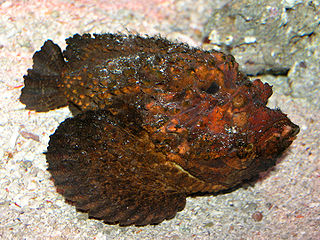
Synanceiinae is a subfamily of venomous ray-finned fishes, waspfishes, which is classified as part of the family Scorpaenidae, the scorpionfishes and their relatives. These fishes are found in the Indo-Pacific oceans. They are primarily marine, though some species are known to live in fresh or brackish waters. The various species of this family are known informally as stonefish, stinger, stingfish and ghouls. Its species are known to have the most potent neurotoxins of all the fish venoms, secreted from glands at the base of their needle-like dorsal fin spines. The vernacular name, stonefish, for some of these fishes derives from their behaviour of camouflaging as rocks. The type species of the family is the estuarine stonefish.

Platycephalus is a genus of mostly marine, demersal ray-finned fish belonging to the family Platycephalidae. They are found in the eastern Mediterranean, the Indian Ocean and western Pacific Ocean.

The leaf goblinfish is a species of marine ray-finned fish, a waspfish belonging to the subfamily Tetraroginae, which is classified as part of the family Scorpaenidae, the scorpionfishes and their relatives. This is the only species in the monotypic genus Neovespicula. It is found in coastal habitats of the Indo-West Pacific region.
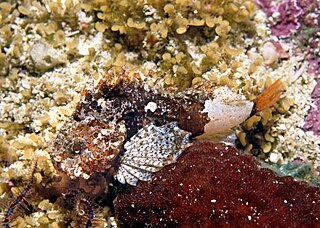
The smoothskin scorpionfish is a species of ray-finned fish, a waspfish belonging to the subfamily Tetraroginae of the family Scorpaenidae, the scorpionfishes and their relatives. It is the only species in the monotypic genus Coccotropsis. This species is endemic to the seas off South Africa.
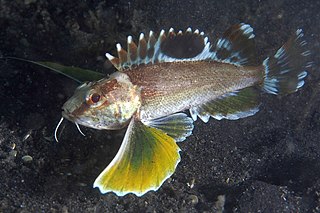
Apistus is a monotypic genus of marine ray-finned fish belonging to the subfamily Apistinae, the wasp scorpionfishes, part of the family Scorpaenidae, the scorpionfishes and their relatives. Its only species is the Apistus carinatus which has the common names ocellated waspfish, bearded waspfish, longfin waspfish or ringtailed cardinalfish, has a wide Indo-Pacific distribution. This species has venom bearing spines in its fins.

Ablabys is a genus of marine ray-finned fishes, waspfishes belonging to the subfamily Tetraroginae, which is classified as part of the family Scorpaenidae, the scorpionfishes and their relatives. The fishes in this genus are found in the Indian Ocean and the western Pacific Ocean.
Liocranium is a small genus of marine ray-finned fishes, waspfishes belonging to the subfamily Tetraroginae, which is classified as part of the family Scorpaenidae, the scorpionfishes and their relatives. The fishes in this genus are found in the eastern Indian Ocean and the western Pacific Ocean.

Ocosia is a genus of ray-finned fishes, waspfishes belonging to the subfamily Tetraroginae, which is classified as part of the family Scorpaenidae, the scorpionfishes and their relatives. These fish are found in the Indian Ocean and western Pacific Ocean.

Paracentropogon is a genus of ray-finned fishes, waspfishes belonging to the subfamily Tetraroginae, which is classified as part of the family Scorpaenidae, the scorpionfishes and their relatives, These fish are found in the Indian Ocean and western Pacific Ocean.

Pseudovespicula is a genus of venomous ray-finned fishes, waspfishes belonging to the subfamily Tetraroginae, which is classified as part of the family Scorpaenidae, the scorpionfishes and their relatives. It has been considered to be a monotypic genus, containing only the type species, Pseudovespicula dracaena, but some authorities classify three species within the genus. The genus is found in the Indo-Pacific region.

Richardsonichthys, is a monotypic genus of marine ray-finned fish belonging to the subfamily Tetraroginae, the waspfishes, which is classified as part of the family Scorpaenidae, the scorpionfishes and their relatives. The only species in the genus is the whiteface waspfish, also known as the whitebelly roguefish, rouge fish, Torres Strait soldier fish or Richardson's waspfish. This species is native to reefs of the Indian Ocean and the western Pacific Ocean.

Snyderina is a genus of ray-finned fishes, waspfishes belonging to the subfamily Tetraroginae, which is classified as part of the family Scorpaenidae, the scorpionfishes and their relatives. These fishes are found in the western Indian Ocean and the western Pacific Ocean.
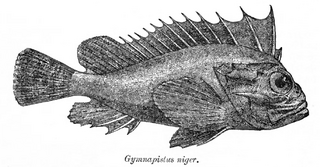
Tetraroge is a genus of ray-finned fishes, waspfishes belonging to the subfamily Tetraroginae, which is classified as part of the family Scorpaenidae, the scorpionfishes and their relatives. These fishes are native to the Indian Ocean and the western Pacific Ocean.

Vespicula is a genus of venomous ray-finned fishes, waspfishes belonging to the subfamily Tetraroginae, which is classified as part of the family Scorpaenidae, the scorpionfishes and their relatives. These fishes are native to the Indian Ocean and the western Pacific Ocean. Although FishBase recognises this genus as valid, other authorities, such as the Catalog of Fishes regard it as a synonym of Trichosomus.

Minous monodactylus, the grey stingfish or grey goblinfish, is a species of marine ray-finned fishes, it is the only genus in the tribe Minoini, one of the three tribes which are classified within the subfamily Synanceiinae within the family Scorpaenidae, the scorpionfishes and their relatives. This species found in the Indo-Pacific and is venomous to humans.

Ablabys macracanthus, also known as the spiny waspfish or as the spiny leaf-fish in Indonesia, is a species of marine ray-finned fish, a waspfish belonging to the subfamily Tetraroginae of the family Scorpaenidae, the scorpionfishes and their relatives. This species is found in the Western Pacific and Indian Oceans.
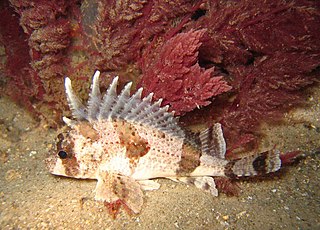
The Eastern fortescue, also known as the fortesque, Southern fortescue, fortie or Southern bullrout, is a species of ray-finned fish, a waspfish belonging to the subfamily Tetraroginae of the family Scorpaenidae, the scorpionfishes and their relatives. It is found the coastal waters of eastern Australia.

The mangrove waspfish, also known as the goblinfish, is a species of marine ray-finned fish, a waspfish belonging to the subfamily Tetraroginae, which is classified as part of the family Scorpaenidae, the scorpionfishes and their relatives. This species occurs in the Indo-Pacific region.
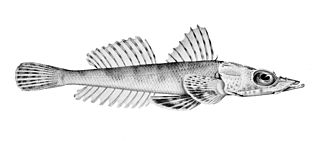
The tuberculated flathead is a species of marine ray-finned fish belonging to the family Platycephalidae, the flatheads. This species is found in Indian and Western Pacific Oceans.



















